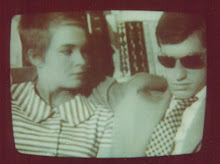Sydney Pollack began working on this documentary about his friend, Frank Gehry, after visiting the 1997 opening of the spectacular Guggenheim Museum in Bilbao, Spain (http://www.guggenheim.org/bilbao) that left him stunned and amazed..."like Don Quixote got stoned and made a building."
Ed Ruscha describes him..."Gehry mixes the freewheelingness of art with something concrete and unforgiving--the laws of physics." He takes enormous risks to create structures that do not blend into the landscape as does much of architecture.
"That is so stupid-looking that it's great," Gehry comments while he creates a model with one of his design partners. The collaborative process begins with Gehry talks suggesting forms as the partner cuts pieces from sheets of heavy metallic paper and use tape to position the pieces to match Gehry's ideas--they jut out, fold and curve. These early models are reworked in various scales and materials and digitized to allow the engineering plans to evolve.
Gehry has been aligned with artists since the 1960s. Other architects laughed at him. He began some of his early experiments by building around his own small bungalow to create an amazing array of levels, textures, light and shadow. Early on, he created more traditional designs to earn a living until a friend coaxed him into giving all that up to create only the artistic work he was best at. When Gehry was a kid, a rabbai told his mother that he had golden hands, as his drawings were so special. Another hand-writing analyst said he would one day be a famous architect. Most of his work begins with pen and ink sketches. He began with art classes in college and eventually found his way into the architecture department. He received an A, but the professor tried to desuade him from the path.
The film is full of interviews with people he had worked with, including Milton Wexler, his therapist for 35 years and Dennis Hopper to commissioned a home design from Gehry. Pollack is behind the camera, but occasionally comes out to share something relevant to the discussion. Pollack mentions one of his favorite lines heard from one of his teachers..."Talent is liquified trouble." Personal frustration often leads to great art. Gehry quotes his favorite line heard once from Pollack and has made it his motto..."There is a sliver of space in the commercial world where you can make a difference."
The Bilbao project is gasp-worthy. "It's foreign to the other buildings around it--has a scale of ancient Egypt," says Julian Schnabel. The shimmering surface lends an otherworldly quality to the experience of witnessing this structure from the humble surrounding town. Locals have experienced a new sense of community self-esteem since the museum's opening--as if they take credit for creating it themselves. Art and Archeology professor, Hal Foster, is a naysayer who feels Gehry gives his clients too much of what they want. Foster says the structures function too much as a spectacle. Schnabel defends Bilbao critics who claim the building competes too much with the art and asks "Maybe the art isn't good enough?" Gehry admits to a lot of mixed feelings about all the controversy and says he was somewhat embarrassed by the completed project at Bilbao. There are certain elments that can only be seen in the final project so there are always areas he wished were different.
Gehry's work is actually that of a contemporary cubist sculptor focused on materials as a way to make beauty with junk...always keeping in mind the mantra of modernism. "Decoration is a sin." In the 1980s when designers were re-doing history, Gehry went way back to the anthromorphic fish form. He created fish lamps and an amazing hotel in Barcelona, Spain. His work is very much a team effort and talks about accepting projects based on whether he likes the people involved.
He is not a painter, but he holds reverence for the artform and his buildings come across as painterly. He says "I'm fascinated with the moment of truth--there's the canvas and the brush and the palette of colors. What do you do? What's that first move? I love that dangerous place."
11/21/10
Subscribe to:
Post Comments (Atom)






No comments:
Post a Comment